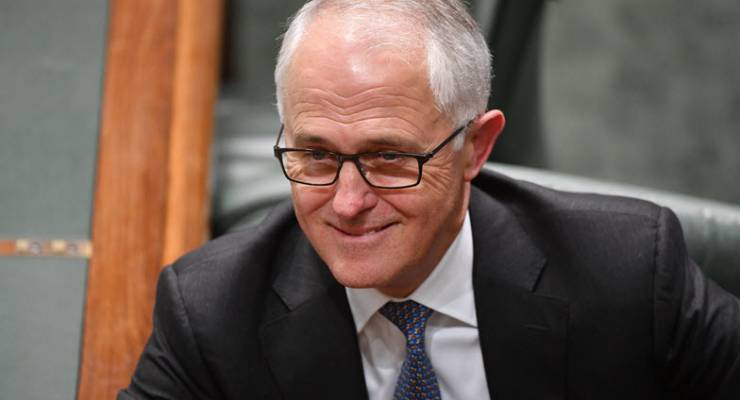
So Malcolm Turnbull finally caught a break. After a shocking run of bad luck and self-inflicted injuries, the Prime Minister was due for some good fortune, and the High Court delivered it yesterday afternoon. If the court had found the government’s attempt to circumvent the Senate’s refusal to support a plebiscite by using an emergency fund to get the Australian Bureau of Statistics to conduct a mail survey was unlawful, it not merely would have revised the marriage equality crisis within Liberal ranks; it would have suggested that this is a government that can’t even do simple things like spend money legally.
We don’t yet know the High Court’s rationale for dismissing the suits brought by marriage equality supporters to halt the survey. But it’s hard to see how it won’t expand the capacity of governments to use the Advance to the Finance Minister for whatever they like, even when Parliament has specifically rejected legislation for that expenditure — as happened in the case of the plebiscite bill. The Advance is currently limited to $295 million but that could be increased in next year’s budget to whatever figure the government likes. Notionally, the Advance is limited to
“… if the Finance Minister is satisfied that there is an urgent need for expenditure, in the current year, that is not provided for, or is insufficiently provided for, in Schedule 1 [which contains portfolio budget spending]:
(a) because of an erroneous omission or understatement; or
(b) because the expenditure was unforeseen until after the last day on which it was practicable to provide for it in the Bill for this Act before that Bill was introduced into the House of Representatives.”
If a trivial rebadging is all that is required (calling a plebiscite a survey) to satisfy the High Court that spending is not something that has not merely been foreseen but the subject of repeated but unsuccessful efforts to secure Senate support, then it’s a low threshold indeed for governments. Henceforth, bump up the Advance to, say, $500 million, or even $1 billion, in the budget bills, then simply spend the money on whatever you can’t get through the Senate.
Admittedly, senates are much more likely to block spending cuts than spending increases, so the threat of renegade expenditure from an executive is probably not that great (though, imagine Tony Abbott, who blew spending out to over 26% of GDP, with even fewer restraints). But the principle is the same: the executive should not spend money that the legislature hasn’t authorised. If this sort of end-run around the Senate is possible, then the spending power of the executive is significantly enhanced.
We were in related but separate territory in 2005 when Greg Combet and Nicola Roxon challenged the Howard government’s use of Department of Workplace Relations funding to advertise WorkChoices, despite no provision being made under the relevant appropriation for advertising of any kind. The High Court decided that it wasn’t its job to second-guess how the executive decided to achieve the outcomes for which appropriations were intended — that was a matter for the government. Indeed, the government’s case to the High Court this time around repeatedly cites the Combet case.
In effect, the High Court — now, of course, very different to its composition 12 years ago — seems unwilling to contest the executive’s right to spend money however it sees fit, regardless of the legislature’s views. It does rather make a mockery of the whole Outcome-Output budget accountability framework under which the Commonwealth has operated for two decades. And depending on the judges’ reasoning, it could make for still further tilting of the balance between executive and legislature further in favour of the former, and allow future governments virtually unchecked spending abilities.








Yep. Quite a win for cronyism – both political and capitalist. First cab off the rank: coal – this is an unforeseen emergency. We need Liddell, so we must purchase it for nice Mr Adani to run so the lights don’t go out. Fuck the market.
Thanks, high court. You really thought this through.
Nice precedent ….. can’t wait for Labor to win power and follow suit – to listen to what this Animal Farm Choir are going to be braying in response.
Judging by the last Labor government, they’ll be bringing the public spend down (they did, even with the fiscal MegaWhoops), while the Tories sit there screaming “BUDGET EMERGENCY” and “SPIRALLING OUT OF CONTROL”
Why even have a high court?
Turnbull was right “the High Court will so hold”.
And they did.
I’m still trying to work out how a voluntary survey on SSM is ‘urgent’ and ‘unforeseen’.
Look forward to reading the High Court’s reasoning on this one…but it does rather leave a nasty taste in the mouth about the largesse this decision has created for governments in the future.
Nudiefish…you asked the wrong question…Why have a representative, democratic parliament if the government/executive can ignore any vote on the floor of parliament…particularly in the Senate????
Doesn’t make any sense to me…we are becoming more like the US, and it’s political Supreme Court, every day.
Clearly me and other contributors have no idea about the laws of the land.
Probably same goes for Anne Twomey and George Williams, the two most senior academic constitutional experts, who, I thought, considered this likely to be a loss for the government.
Apologies to those two academics if I misinterpreted their prognostications.
The disconnect with us plebs just keeps growing.